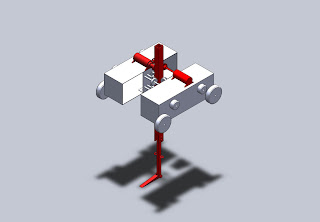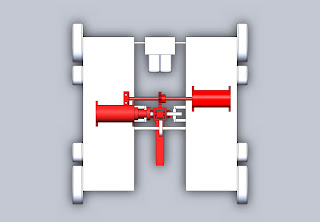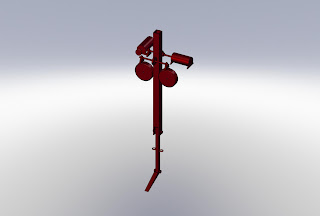This semester in ME250 was a complete success. We learned skills ranging from design and manufacturing to teamwork to time management. These aspects are key to becoming a well-rounded engineer.
Transforming our dreams and designs into reality in our complex robot was very enjoyable. It is amazing watching scrap being turned into a masterpiece. However, this transition from design to the actual manufacturing was also very difficult. I learned that you have to make sure that the all the tolerances on every dimension of a part is consistent, otherwise the other pieces may not mate well or you may add damaging stress or strain to your machine, including unneeded friction. For example, we don’t exactly know the reason why our chassis wouldn’t drive straight, but I believe it is because our tolerances were too small on the holes and alignment of the axles in the bushings to the double gearbox. The slightest misalignment could cause too much friction to build up in the bushing, therefore causing there to be too much strain on the gears in the double gearbox. This most likely on happened on one side, causing it to turn in the same direction every time. Another obstacle that was hard on our group’s manufacturing process was the fact that we weren’t thinking of how difficult it would be to actually make some parts in the machine shop when we were designing them. The foot (wedge) of our arm was the most difficult piece for me to manufacture. We had to make sure that our arm wasn’t too heavy, or else we would have to change the gear ratio needed to move it. We thought of making the arm out of different metals and even different types like sheet metal or square stock. Our final decision was to stick to the original plan of making it out of the solid aluminum block, but I had to be perfect on my measurements during manufacturing. Long story short is that it took close to two and a half hours to make this one piece using the consistency and preciseness of the milling machine. This piece and others like it, with the same problem of the simplicity of manufacturing, took way too much of our team’s time putting us in a rush to finish toward the deadline.
Another aspect of this class was the point of working as a team and all collaborating together as a group to achieve the same goal. Thankfully I was blessed with a great bunch of extremely bright guys that made brainstorming a breeze. We could easily come up with ideas to solve problems and get the job done. Unfortunately my team didn’t really have much machine experience (other than Andrew and me) but like in all aspects of the project, if someone struggled with a skill, someone else was there to excel in what was required. Dylan was great with solidworks while Chan was a genius with the analysis, leaving me and Andrew to be masters in the shop. We were all there to help each other, but the problem with our group was finding time for all of us to meet. The fact that I live on central campus while the others live on north campus and that all of us have completely different schedules and commitments made it very difficult for us to come together. This made time management very crucial, and while, looking back, there was room for improvement, but we managed to finish the project on time and met expectations.
For the future, I believe this class, as a whole, should make a few changes. First off, the workload of the semester was a nightmare. At points in the year, I thought I was in an eight credit hour class due to the number of homework assignments and the time period to do it all. Seeing that previous years made model computer mouses and cup holders, some of the assignments (although helpful to our understanding of technology and informative about some of the basic requirements of an engineer) should have been cut from the curriculum due to the length of the semester. Overall, despite hating it at certain, stressful points, I enjoyed the class and what we learned was very interesting.

























